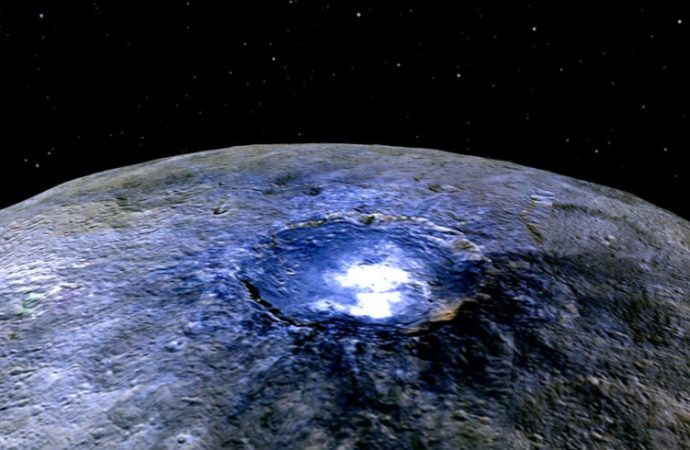That could tell us something really interesting about Earth.
Scientists have just found organic molecules on the Ceres, the dwarf planet hidden in the asteroid belt between Mars and Jupiter. The find is particularly exciting because this is the very first, unambiguous detection of organic molecules on an asteroid.
This new discovery was just announced by team of planetary scientists led by Maria Cristina De Sanctis, an astrophysicist at the Italian National Institute of Astrophysics in Rome. The scientists used data from NASA’s Dawn space probe, which was launched in 2007 and is currently in orbit around Ceres. The discovery was announced today in the journal Science.
“We see a lot of interesting chemistry on Ceres,” says De Sanctis, and “this is the first time we have seen such a clear [organic] signature on an extraterrestrial body.”
Spawned on Ceres
The Dawn space probe found Ceres’ organic molecules with an instrument called a visible and infrared light spectrometer. Even from orbit, that instrument was able to scour the light reflected off Ceres to detect what type of molecular matter is on the surface. That’s because certain molecules absorb very specific frequencies of light, and can be discovered by missing gaps of light that are picked up by the probe.
Near a large crater on Ceres’ northern hemisphere, called the Ernutet crater, the space probe found a distinct molecular fingerprint in the light. It was the signature of a class of organic molecules that have methyl and methylene groups. These are basically chemical chunks of carbon and hydrogen atoms grouped together, such as CH3 and CH2. Dawn couldn’t tell exactly which molecules were down on Ceres, but they’re likely to be tar-like minerals such as kerite or asphaltite. In a word: organics.
Although the organic molecules were found near a crater, De Sanctis and her colleagues are pretty confidant that the molecules actually formed on Ceres itself—that is, they didn’t hitch a ride from someplace else aboard whatever space rock created the impact crater. Why? The class of organic molecules discovered on Ceres are damn delicate, and the heat of the impact involved the crater’s creation would have utterly destroyed them. They must have been made afterwards.
Organic Trove
When people hear “organic,” they think “life.” But with chemistry, that’s not necessarily so. Although organic sounds a whole lot like organism, in the parlance of chemists the word basically only means ‘stuff with carbon atoms in it’.
So what’s the fuss? There are two big reasons to be excited about this new discovery.
First, the fact that organic molecules naturally formed on Ceres offers a tantalizing clue about the evolution of life on Earth. We know that life microbial life evolved on Earth after an epic shelling of Earth by asteroids and comets, a period called the Late Heavy Bombardment. Many scientists already believe that Earth’s oceans were formed at this time, when liquid-heavy asteroids and comets thudded down like monster water balloons. But some also wonder: Could the chemical precursors of life (or perhaps even life itself) have been delivered to Earth in the same way?
Today’s discovery that organic molecules naturally arise on an asteroids offers evidence that yes, they could have. At the very least, the building blocks for Earth’s life could have spawned in the cosmos and flew in like dandelion seeds on asteroids.
The building blocks for Earth’s life could have spawned in the cosmos and flew in like dandelion seeds on asteroids.
But there’s another reason to be excited about this find on Ceres. No, having organic molecules doesn’t mean there’s life on Ceres—but it does make it more likely. Michael Küppers, a planetary scientist at the European Space Agency who was not involved in the research, writes in an accompanying essay: “Because Ceres is a dwarf planet that may still preserve internal heat from its formation period and may even contain a subsurface ocean, this opens the possibility that primitive life could have developed on Ceres itself.”
This would put Ceres on par with Saturn’s moon Enceladus, which has active geysers of water ice, an enormous inner ocean, and the potential for some form of water-bound life. Such a find would also snatch away the title of “Coolest Dwarf Planet” from Pluto, dealing that plucky iceball yet another degrading blow.
Source:

































Leave a Comment
You must be logged in to post a comment.